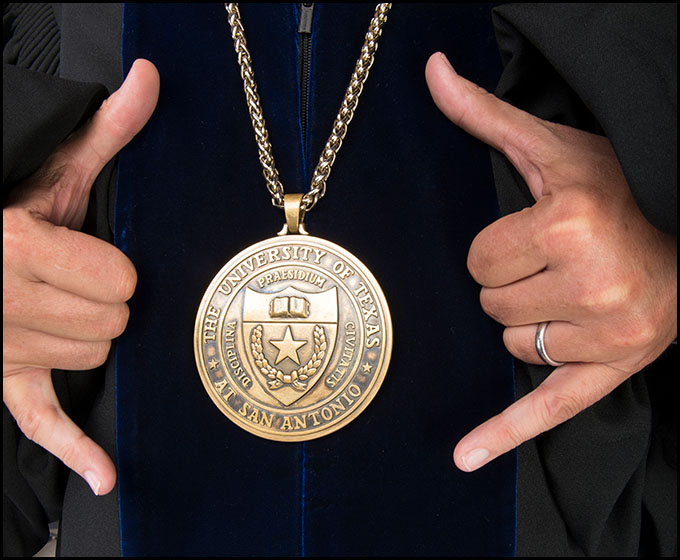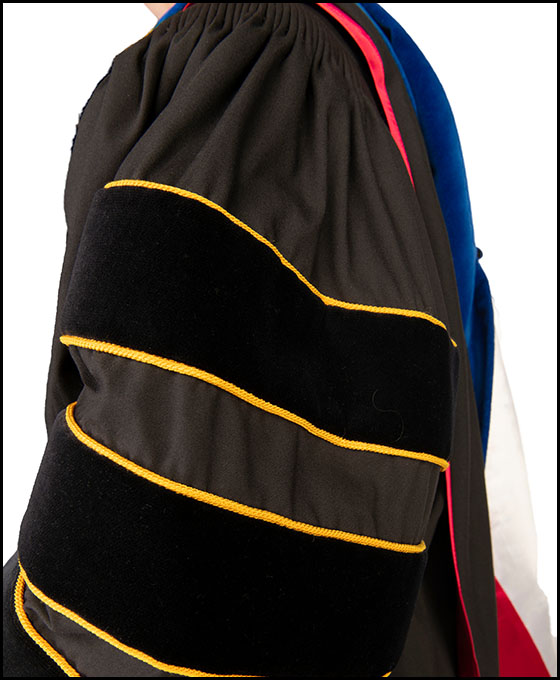DECEMBER 12, 2022 — During a typical Commencement celebration at UTSA, everyone is wearing a cap and gown, but some look very different than others. UTSA Today has tapped into the history behind the academic regalia to find out what the different colors and styles represent.
The tradition of the academic dress dates back nearly eight centuries. In medieval Europe, all townsmen wore long, flowing robes or gowns. The materials and colors varied greatly, according to the wealth and rank of the individual and were governed by royal decree. Gradually, distinctive gowns were developed for the various professions, trades and guilds. Today, this tradition remains for gowns of religious orders and judiciary and in academic regalia.
Through the years great diversity in color and style of cap, gown and hood have evolved. In 1895, a commission was established to come up with a uniform code for academic costume. Today, the gowns, hoods and mortarboards worn by the graduating students of most institutions, including UTSA, follow this code.


Bobby De Leon is a first-generation student who earned his bachelor's degree in music education.

At UTSA, the gowns and mortarboards are navy blue. The style of the gowns vary depending on the degree the student receives. The sleeves of the gowns worn by the master’s degree recipients are square at the end. The doctoral degree recipients’ gowns have flowing sleeves with three bars of velvet and a facing of velvet down the front with the UTSA seal. The velvet trim is five inches wide for the doctoral degree. The color of the velvet border indicates the degree and align with the tassel colors listed below.



The biggest difference in regalia can be found in the hood, which identifies the graduate degree and institution in which it was awarded. For master’s students, the hood is short. For those receiving a doctoral degree, the hood is longer and lined with silk in the official colors of the student’s institution. UTSA’s hoods are lined in orange with one white chevron.



The academic caps have their own special meanings. Developed in the 15th century, some caps were stiff, some soft, some square and some round with a tuft in the center. The tassel used today is an elaboration of the tuft. While some institutions still use the round caps, most institutions, including UTSA, have adopted the mortarboard style that comes from Oxford University. Students earning terminal degrees wear a tam.
The tassel color for graduate degrees indicates the discipline in which the degree has been earned, except that a gold bullion tassel is worn by recipients of doctoral degrees. For a bachelor’s degree, the tassel's colors represent the university in a tricolor of orange, blue and white. The gold cord, worn by some undergraduate students, indicates graduation with honors: summa cum laude, magna cum laude or cum laude.
UTSA leadership and faculty wear the robe specific to the university where they earned their highest degree. President Taylor Eighmy’s regalia is indicative of the University of New Hampshire, where he earned his Ph.D. in environmental engineering. Eighmy is in the Roadrunner spirit with his orange hood, which actually signifies his engineering degree. He also wears the UTSA Presidential Medallion, which symbolizes the authority and responsibility vested in the President. The brass medallion has the university seal on one side and the words “Presented by the UTSA Development Board in honor of the University’s 25th anniversary—1994” on the other side.


President Eighmy’s hood represents his Ph.D. in environmental engineering. He also wears the UTSA Presidential Medallion.

Provost and Senior Vice President for Academic Affairs Kimberly Andrews Espy purchased her regalia when she was a faculty member at Southern Illinois University and needed it to participate in the hooding of her first doctoral student. The hood is red and white, representing her doctoral alma mater, University of Houston, and the piping on the sleeve chevrons is gold, representing her science degree. Her favorite features of the gown are the buttons that anchor the hood in place: one hidden inside the zipper and another on the back. Another distinguishing feature of her regalia is what it lacks—like a number of faculty, Espy eschews tradition by wearing neither a tam nor mortarboard at ceremonies.



Tassel and Hood Colors for Graduate Degrees
Blue Violet: Architecture, Urban and Regional Planning
Brown: Art, Interior Design
Citron: American Studies, Anthropology, Bicultural and Bilingual Studies, Geography, Mexican American Studies, Social Work
Copper: Economics
Crimson: Communication
Dark Blue: Justice Policy, Philosophy, Political Science
Drab: Business, Data Analytics
Gold: Criminal Justice, Psychology
Golden Yellow: Sciences, Mathematics
Light Blue: Education
Pink: Music
Orange: Engineering
Peacock Blue: Public Administration
Sage: Health, Kinesiology, Public Health
White: Classical Studies, History, Humanities, Multidisciplinary Studies, Sociology, Languages, Women's Studies
UTSA Today is produced by University Communications and Marketing, the official news source of The University of Texas at San Antonio. Send your feedback to news@utsa.edu. Keep up-to-date on UTSA news by visiting UTSA Today. Connect with UTSA online at Facebook, Twitter, Youtube and Instagram.
Move In To COLFA is strongly recommended for new students in COLFA. It gives you the chance to learn about the Student Success Center, campus resources and meet new friends!
Academic Classroom: Lecture Hall (MH 2.01.10,) McKinney Humanities BldgWe invite you to join us for Birds Up! Downtown, an exciting welcome back event designed to connect students with the different departments at the Downtown Campus. Students will have the opportunity to learn about some of the departments on campus, gain access to different resources, and collect some giveaways!
Bill Miller PlazaJoin us for an intimate evening of cocktails, conversation, and culinary inspiration with Pati Jinich, Emmy-nominated chef and James Beard Award-winning author. Enjoy light bites and signature drinks in the warm, modern setting of Mezquite as Pati connects with guests over her passion for Mexican cuisine and storytelling.
Mezquite Restaurant in Pullman Market, 221 Newell Ave., San Antonio 78215From inspired courses to thoughtful pairings and a rich sense of community, the Ven a Comer Signature Dinner is a night of shared meals, shared stories, and unforgettable flavor.
Stable Hall (Pear Brewery), 307 Pearl Pkwy, San Antonio 78215Come and celebrate this year's homecoming at the Downtown Campus with food, games, giveaways, music, and more. We look forward to seeing your Roadrunner Spirit!
Bill Miller PlazaThe University of Texas at San Antonio is dedicated to the advancement of knowledge through research and discovery, teaching and learning, community engagement and public service. As an institution of access and excellence, UTSA embraces multicultural traditions and serves as a center for intellectual and creative resources as well as a catalyst for socioeconomic development and the commercialization of intellectual property - for Texas, the nation and the world.
To be a premier public research university, providing access to educational excellence and preparing citizen leaders for the global environment.
We encourage an environment of dialogue and discovery, where integrity, excellence, respect, collaboration and innovation are fostered.